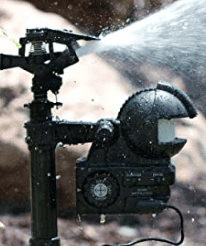Deer Repellent Spray vs.Mechanical Control
Should we go all in on repellent or resistant plants or mechanical control? The decision to go with deer repellent spray vs mechanical control can be a hard one. Both have pros and cons. The real answer is that you probably need to use both.
Deer are amazing creatures, able to leap tall buildings in a single bound, and also able to strip a garden in minutes flat. Having a deer problem is not only frustrating, it can be extremely dangerous as deer are large animals, capable of inflicting severe damage to cars, homes, and humans, especially when disturbed during rut. So, how do you deter these lovely devils in disguise?
The answer is it varies. A number of factors come into play when determining the best method for deterring nuisance deer. There are several methods that can be employed to keep deer away from your property with the most popular being sprays and mechanical means.
Deer Repellent Pros and Cons
Deer repellent sprays come in a variety of scents and flavors, all with one thing in mind, to make the deer feel a little less at home. These sprays are generally used on foliage that the deer are finding particularly delectable, making them unpalatable, and forcing the deer to look elsewhere for an easy meal. The pro’s for using sprays is that they are relatively inexpensive, easy to use, and do not harm the deer or the environment.
To use a deer repellent spray, you simply spray the contents onto the leaves, stalks, flowers, and any other exposed plant material at a minimum of every other day, especially after a rain, for the first few weeks, then once a week or so for several months thereafter, or any time you see a deer checking out the menu. The drawbacks: Having to be extremely diligent in applying the product as the deer will quickly learn to avoid the area on the days you treat and will continue to come on the days you don’t. Secondly, a child or household pet could come in contact with the spray, and while they are generally not harmful, it could make for a very unpleasant experience.
Deer Repellent Mechancial Control
Deer repellent mechanical devices range anywhere from netting to fencing to motion detection sprinklers. These devices will physically bar a deer from a particular area. The pros: there are no chemicals to expose any “non-target” animals to and the diligence aspect is covered by regular inspections of the mechanical repellent to ensure that it hasn’t been damaged by determined deer or the elements. The drawbacks: mechanical repellents can be damaged by an angry or determined animal and can be somewhat expensive to install, operate, and maintain.
Both of these methods have been proven effective in reducing the number of deer in any particular area, so when choosing a method of repellent, keep your budgetary constraints, severity of your problem and the amount of effort you are willing to put into eradicating your nuisance deer in mind and make an informed decision.
If you have a nuisance, whether it belongs to the local wildlife population (like the kamikaze squirrels that plague your yard), or just wishes it did (your neighbor’s wayward dog, for instance), you have probably wondered how to discourage it from hanging around your premises. Let’s face it, there’s nothing more frustrating than replanting the flowerbed every time that darn skunk digs them up, and who hasn’t thrown up their hands in disgust after sitting down in your freshly washed and waxed vehicle to find yourself staring through cat prints on the windshield.
The good news is that it doesn’t have to be that way. There are many ways to skin that cat (not literally) and deter these pests.
Making The Best Deer Repelling Choices
The first thing to consider when purchasing a chemical repellent, which, by the way, happens to be one of the more effective repellents on the market today, is whether to use one with natural ingredients or synthetic.
Most chemical repellents are designed to smell like large predator urine. There is nothing more effective at keeping smaller prey animals at bay than making them think there is something lurking around the corner, ready to eat them. This is why these repellents are so effective. They tap into the natural instincts of self preservation of the pest in question, and rather than take a chance on being wrong, they tend to avoid areas where they feel threatened. Synthetic repellents are designed to mimic the smell of predator urine, and science has come pretty close to duplicating nature.
The problem is, pretty close may not be good enough to keep more aggressive animals at bay. Not to mention that synthetic chemicals are usually less environmentally friendly, and may pose a larger risk to your children and household pets who will probably come into contact with the repellent at some point.
A better choice would be to use a natural chemical repellent. They tend to be a bit more expensive, since you have to pay the salary of the guy who actually has to collect the bear or mountain lion urine, but the results are well worth the cost. Plus, since the repellent is 100% organic, it is biodegradable and does not pose a health risk to your loved ones (or that darn cat!)
When considering a chemical repellent to deter nuisance animals from your yard, choose a natural compound. You’ll be glad you did.+


